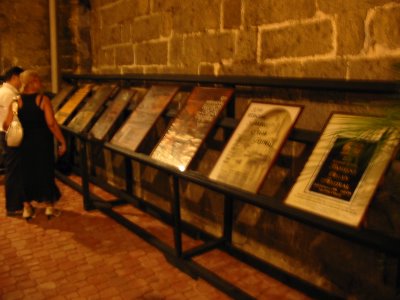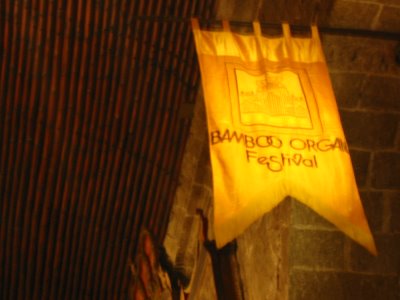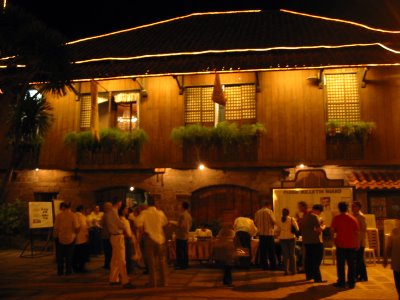And what better way to start this tribute than by featuring the opening night of the traditional International Bamboo Organ Festival, now on its 31st year. I attended the second night, the first night being a command performance for her H.E. President GMA. Forgive me for the bad photos (bad camera, slow shutter speed, etc). At any rate, welcome to my home city!

Welcome to Las Piñas City's pride and joy. Established in 1795 (the historical plate mentions a different date though), it is home to the world's one and only mostly-bamboo chamber organ
The facade of the Parish of Saint Joseph the Worker, more known to cab drivers and locals simply as the 'bamboo organ church.'
The commemorative plate by the National Historical Institute (NHI). Click on photo to read inscription. If you need an English translation, do let me know. I'd be glad to provide you one.
UPDATE: An English translation is now available in the comments section below, as per Sidney's request. Cheers!

The belfry tower's bells ring to signal the start of the performance. The statue of Fray Diego Cera, a Spaniard and the first curate of this parish, can be seen on the lower left side.

Detail of the statue showing a Filipino assistant working on bamboos used to build the organ

Guests, both local and foreign, wait for the church's side door to open

The festival souvenir booklet at Ps 60.00 each (Why is it called a "souvenir" if we have to buy it?)

A view of some of the posters used through the years for the festival

The empty stage before the performance

A festival banner near the ceiling

Guests milling infront of the old convento (now a museum and gift shop) during the ten-minute break

Parols - hold-over decor from last Christmas - sway in the night wind

A view of the stage (built behind the main entrance rendering the latter unusable). Notice THE bamboo organ on the top right, the bamboo ceiling. and the choir loft on top of the stage

Curtain call of the performers (taking photos during the performance is forbidden)

2nd curtain call

Some members of the choir which sings during daily Mass give way for the Festival Choir and instead serve as ushers for the 5-night event. That's Irene Marcos, by the way, posing with the ushers.

Dazed, tired after a looong day but uplifted nonetheless. I hope you enjoyed our recent trip! T'will be a great honor to see you around Las Piñas soon.

5 comments:
I'm a Manilenyo and haven't attended any of the Bamboo Organ Festivals over the years. I think it's time to make the trip. Great pics.
Hello, Ms Mila! Thanks for visiting my blog and leaving a comment. How were you able to locate G.G.G.? :-)
Yes,(shame on me) I can still use an English translation !
I think i saw a link through another blog. Can't remember which one, but thanks to your post, I now own a t-shirt from the graphics company. Really cool design too!
Sidney: here goes! I'd try my best to give you a good translation. I actually had you in mind when i wrote that comment, he he!
__________________
"CHURCH OF LAS PIñAS
Established into a pueblo (town), 1762. Separated from the parokya (parish) of Parañaque, 1775. Padre Diego Cera of our Lady of Mount Carmel was appointed the first parish priest (kura paroko), December 26, 1795.
He had the stone church built, 1797-1819, and the organ made of 902 bamboos and 129 metal pieces, 1816-1824. Slightly destroyed by an earthquake (the church, not the organ), 1828 and 1863 and yet again with a series of earthquakes in 1880. Mass was never held in it again. Repairs were done in 1883 but were not completed. It was used as a camp during the Japanese Occupation and as a hospital during the Liberation.
Upon the initiative of the community and of the Historical Conservation Society, it was returned to its former glory, 1962-1977."
____________________
Interesting history, yes? You must come and see it, Sidney.
Mila: Buti pa po kayo may shirt na! Wala nga po ako time to go there! :-(
Post a Comment